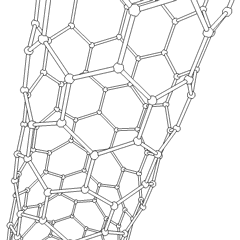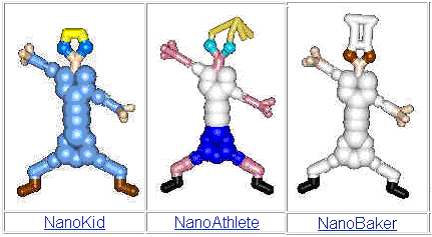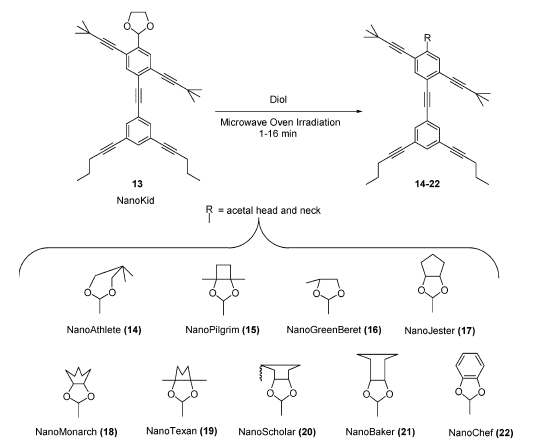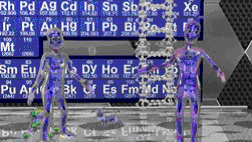

“Bond with me?” – ‘NanoKids’ Head to School
Isa Chan
Ever seen molecules that look like humans? Dr James M. Tour at Rice University welcomes you to the world of NanoPutians.
 |
NanoKids are 2 nanometre tall anthropomorphic figures comprised of organic molecules. This means while they are not alive, they have characteristics, resembling human features, for example a head, arms etc. The NanoPutians come in many different forms. Their bodies are made from carbon and hydrogen, and their eyes are oxygen atoms.2, Common names based on their individual anthropomorphic designs are assigned to the NanoPutians.3 The basic building block is the NanoKid, and from this, a whole family of variants were made including NanoAthlete and NanoBaker

Space filling models of NanoKid, NanoAthlete, and NanoBaker © 2003 NANOKIDS.4

NanoKid (13) afford a new series of NanoPutians from chemical reactions resulting in head conversions. © 2003 NANOKIDS3
Dr. James Tour respected nanoscience researcher at Rice University in the United States of America came up with the idea for these miniature people in 2003. Why you may ask? As a father of four, Tour has experienced first hand how younger generation views and, in some cases, suffers through science.5 He recalls one night when his 15-year-old daughter was doing her boring chemistry homework and exclaimed, “I can’t believe you do this for a living, Dad!”6 What concerned Tour the most, was that kids think about science today as facts that they can’t do anything with.
The logic to chemical synthesis is the progression of attaching building blocks of molecules. “Why not teach chemical concepts by attaching arms and legs to molecules?” Tour thought. His six-year-old son drawing limbs and applying human features to his chemistry drawings inspired him and his team to develop the NanoPutians as a way to teach kids about nanoscience. Getting down to the nanoscale gives students an appreciation for why things have the properties they do, and how nanotechnology can help to solve some of the world’s most serious health, environmental, and energy problems.7 Tour hopes to spread his fascination for science in a fun and interactive way that will help kids to retain some interest.
Zooming in to the Nanokids world takes us to the NanoLoft – a nanoscale hangout in a computer’s jungle of circuits and transistors. This educational package consists of a choice between an animated 2-D interactive online program and a short DVD with science rap and animation that Tour’s group have put together. The adventure begins viewing the world through the eyes of a NanoKid as it pulls atoms from the periodic table and combines them.

NanoKid hangs out at the NanoLoft © 2003 NANOKIDS
Children should understand fundamental concepts of atoms and chemical bonding by navigating their way through this game-like educational package.
To date, Tour and his team have invested many hours and funds in the hope that this will become a good and fun learning tool. The NanoKids project is a success and has already received numerous positive feedbacks from both parents and teachers, and the most important of all, “kids love it!” says Tour. “If someone doesn’t like it, it’s because they’re too old.” Although the project has made headway into some schools, professional evaluations are still being conducted before its release for general distribution. The results from the 2004-2005 student preference and usability surveys in beta-testing indicated that 77% of the students said the NanoKids helped them to understand at least one thing that they found difficult to learn, and 82% of the students said that using the NanoKids materials made learning science more interesting.8
Learning about the NanoKids has opened up a new potential teaching method to kids at school, while talking about how exciting research on a small scale “has an aura of being something really cool.” Unlike the impression every kid have about chemists being ‘nerdy, wearing big thick glasses’ and so forth, chemists do have a sense of humour after all!
Refeneces:
1. NanoKids (2003). Getting Down to the Nanometer Scale, viewed 24 June 2005, http://nanokids.rice.edu/explore.cfm
2. Picher, H. R., NanoKids made in lab, published online: 14 October 2003, viewed 24 June 2005, www.nature.com/nsu/031013/031013-3.html
3. Chanteau, S. H. and Tour, J. M., J. Org. Chem., 68(23), 8750-8766, 2003.
4. NanoKids (2003). Cast, viewed 24 June 2005, http://nanokids.rice.edu/cast.cfm
5. Rovner, S. L., C & CN News, 82(14), 71-73, 2004.
6. Nanotechnology Initiative, Meet Nanoscientist Jim Tour, viewed 24 June 2005, http://www.nano.gov/html/edu/JTour.html
7. Sohn, E., The incredible Shrunken Kids, Science News for Kids, published online: 9 June 2004, viewed 24 June 2005.
8. NanoKids (2003). Mission, viewed 24 June 2005, http://cohesion.rice.edu/naturalsciences/nanokids/mission.cfm?doc_id=4702
OnSET is an initiative of the Science Communication Program
URL: http://www.onset.unsw.edu.au/ Enquiries: onset@unsw.edu.au
Authorised by: Will Rifkin, Science Communication
Site updated: 7 Febuary, 2006 © UNSW 2006 | Disclaimer
OnSET is an online science magazine, written and produced by students.
![]()
OnSET Issue 6 launches for O-Week 2006!
![]()
Worldwide
Day in Science
University
students from around the world are taking a snapshot
of scientific endeavour.
Sunswift
III
The UNSW Solar Racing Team is embarking
on an exciting new project, to design and build the
most advanced solar car ever built in Australia.
![]()
Outreach
Centre for Sciences
UNSW Science students can visit your school
to present an exciting Science Show or planetarium
session.
![]()
South
Pole Diaries
Follow the daily adventures of UNSW astronomers
at the South Pole and Dome C through these diaries.
News in Science
UNSW is not responsible for the content of
these external sites